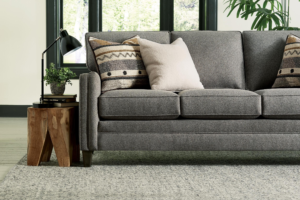Velvet is a luxurious and elegant fabric often used in sofa upholstery, but it requires special care to maintain its rich texture, color, and appearance. Velvet’s soft, plush pile can be easily damaged by dirt, spills, or improper cleaning methods, so it’s essential to adopt the correct cleaning and maintenance practices. Below, we’ll provide a comprehensive guide on how to clean and maintain velvet sofa fabric, ensuring it remains as beautiful and luxurious as the day you purchased it.
1. Regularly Vacuum Your Velvet Sofa
Base Layer: Velvet’s dense pile can trap dust, dirt, and pet hair, which, if left unattended, can cause the fabric to lose its sheen and texture. Regular vacuuming is the best preventative measure to keep your velvet sofa clean and fresh.
Middle Layer: Use a vacuum cleaner with a soft brush attachment to gently lift dirt from the surface of the fabric. Be sure to vacuum in the direction of the nap, or the natural alignment of the velvet fibers, to avoid damaging the fabric or flattening the pile.
Surface Layer: Make vacuuming a regular part of your cleaning routine, ideally once a week, to prevent buildup of debris and ensure your velvet sofa stays soft and plush.
2. Spot Clean Spills Immediately
Base Layer: Prompt action is critical when it comes to spills on velvet. Velvet is more prone to stains than other fabrics, and letting a spill sit can cause permanent damage.
Middle Layer: Use a clean, dry cloth or paper towel to blot the spill immediately. Do not rub the fabric, as this can push the liquid deeper into the fibers and cause the pile to flatten.
Surface Layer: If the spill is liquid (like wine, coffee, or juice), gently blot it until the area is mostly dry. If the stain persists, use a small amount of mild dish soap mixed with water, and carefully dab the stained area with a dampened cloth.
3. Use Steam for Deep Cleaning and Reviving the Pile
Base Layer: Over time, velvet can lose its soft, plush feel, especially in high-use areas. One of the most effective ways to restore its texture and revive the pile is to use steam.
Middle Layer: Hold a handheld fabric steamer a few inches from the fabric and steam the surface of the velvet. The steam will relax the fibers, causing the pile to rise and regain its softness. Always steam in the direction of the nap to maintain a uniform texture.
Surface Layer: After steaming, use a velvet brush or soft-bristle brush to gently lift the fibers and restore the fabric’s plushness. Be careful not to press too hard on the fabric while brushing, as this can cause damage.
4. Clean Light Stains with a Gentle Upholstery Cleaner
Base Layer: For light stains, especially those from oils or food, use a specialized upholstery cleaner that is safe for velvet. Avoid harsh chemicals that could damage the fabric.
Middle Layer: Before applying any cleaner, always test it on an inconspicuous area of the fabric to ensure it won’t discolor or damage the velvet. Apply the cleaner according to the product instructions and use a soft cloth or sponge to gently blot the stained area.
Surface Layer: Avoid over-wetting the fabric when cleaning. Too much moisture can damage velvet, so always make sure the fabric dries completely before use.
5. Professional Cleaning for Deep Stains and Heavy Cleaning
Base Layer: Velvet is a delicate fabric, and there may be times when DIY cleaning methods aren’t enough, especially for stubborn stains or deep cleaning needs. In these cases, it’s advisable to hire a professional cleaner experienced with velvet upholstery.
Middle Layer: Professional cleaners will have the expertise and tools necessary to clean velvet thoroughly without damaging the fibers. They may use dry cleaning methods or steam cleaning techniques to preserve the fabric’s texture and appearance.
Surface Layer: Depending on the level of dirt and the type of velvet, professional cleaning may need to be done every 1-2 years to maintain the fabric’s luxurious appearance.
6. Use Fabric Protector to Prevent Future Stains
Base Layer: After cleaning, you may want to apply a fabric protector to help prevent future stains and spills. Look for a stain-resistant spray that’s specifically designed for velvet or upholstery fabrics.
Middle Layer: Fabric protectors create an invisible barrier on the fabric that repels liquids and dirt, making it easier to clean any future spills. Be sure to follow the manufacturer’s instructions when applying the protector.
Surface Layer: Reapply fabric protector every 6-12 months, depending on usage, to maintain its effectiveness. This added layer of protection will help keep your velvet sofa looking fresh and new.
7. Keep Velvet Away from Direct Sunlight
Base Layer: Velvet is prone to fading if exposed to direct sunlight for extended periods, which can cause the fabric to lose its color and vibrancy.
Middle Layer: To protect your velvet sofa, try to place it away from windows with direct sunlight or use sheer curtains to filter the light. Alternatively, UV-blocking window films can help prevent the sun’s rays from damaging the fabric.
Surface Layer: If your velvet sofa is near a sunny window, rotate the cushions and seating areas periodically to ensure even exposure to light and avoid uneven fading.
8. Avoid Excessive Pressure on the Fabric
Base Layer: Velvet is a delicate fabric, and excessive pressure can crush or flatten the pile, causing shiny spots that are hard to reverse.
Middle Layer: Be mindful of heavy furniture or objects resting on the velvet sofa for prolonged periods. Avoid sitting on the same spot repeatedly, and rotate cushions to ensure even use.
Surface Layer: If possible, avoid footstools or heavy throws on velvet furniture unless they are designed to support the weight without damaging the fabric.
9. Rotate and Fluff Cushions Regularly
Base Layer: Frequent use of a velvet sofa can cause some areas to flatten, leading to uneven texture and wear. To avoid this, regularly rotate and fluff your cushions.
Middle Layer: Turn cushions and seat covers every few months to ensure even pressure and prevent certain areas from wearing out faster than others. Fluff cushions regularly to maintain their shape and volume.
Surface Layer: This practice helps the velvet maintain its plush, full appearance and reduces the risk of permanent damage to the fabric.
10. Avoid Abrasive Cleaning Tools
Base Layer: When cleaning velvet, avoid using abrasive cleaning tools like stiff brushes, harsh sponges, or abrasive cloths, which can damage the delicate fibers of the fabric.
Middle Layer: Instead, use a soft-bristled brush, microfiber cloths, or specialized velvet brushes that are designed to preserve the integrity of the fabric while maintaining its texture.
Surface Layer: Always be gentle and mindful when cleaning or handling velvet to avoid unnecessary wear and tear. The more delicate the fabric, the more gentle your approach should be.
Conclusion
Maintaining a velvet sofa requires careful attention and regular upkeep to preserve its luxurious appearance and texture. By vacuuming regularly, spot cleaning spills promptly, and using methods like steaming or fabric protectors, you can keep your velvet sofa looking beautiful and soft for years. For more extensive cleaning, consider professional care to ensure the fabric stays in top condition. With the right maintenance, velvet upholstery can be a long-lasting and stunning addition to your home.











